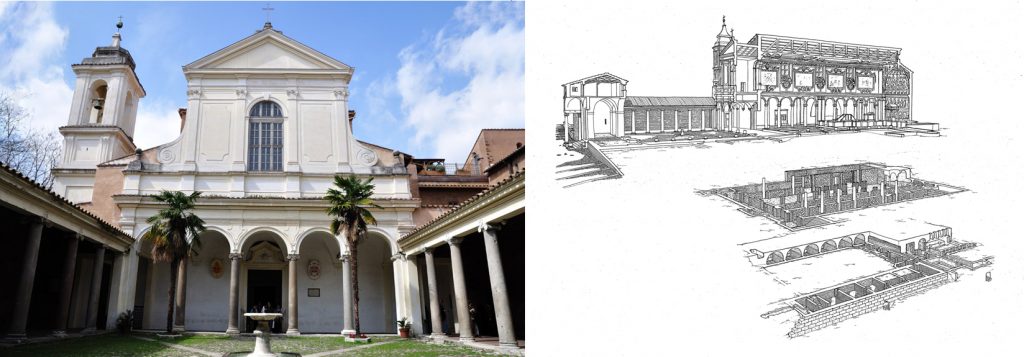The Basilica and the Excavations

The Basilica with its underground archaeological complex is one of the world’s great treasures, a place loved by pilgrims, students of art and visitors from all over the world. Here, as in no other place, one can visit and experience different levels of Rome’s past. Descending below the present church, one enters a 4th century church containing some of the world’s finest medieval frescos, dating from the 8th to the 11th century. Going down lower again, one enters the 1st century area with its Mithraic temple, and across a narrow alleyway, a large public building, around whose foundations flow the lost waters of ancient Rome. Above the excavation stands the present 12th century Basilica, with its magnificent mosaic, early renaissance frescoes, the 6th century marble chancel from the earlier church, the Cosmatesque floor, etc
What you can visit
The Basilica of San Clemente is in fact made up of two churches, one built over the other. The lower church was in turn built over Roman buildings of the 1st century. One of these buildings houses an ancient Mithraic temple. Visiting San Clemente means making a real voyage of discovery into the long history of the city, where at every turn one can observe its evolution through the centuries. San Clemente is a place that never ceases to fascinate, its wealth of history and art continuously gives rise to new studies that challenge to our understanding of the past.
Upper 12th century Basilica
One enters the present Basilica from Piazza San Clemente, through the 12th century gatehouse and a colonnaded forecourt or atrium. Inside the basilica, one is immediately struck by the Mosaic of the Apse and the wonderful pavement, with its great variety of ancient Roman marble, laid out in a wonderful pattern of Cosmatesque work. Before the sanctuary and altar, there is an unusual marble chancel. The present arrangement of the choir or schola cantorum, with its two ambos for the readings and twisted column for the paschal candle is medieval. However, the panels of the enclosure we see today, were actually carved in Constantinople in the 6th century. They were made for the lower church where they served to form a sort of processional corridor from the entrance to the high altar. The upper basilica has indeed a wealth of fascinating features but its great glory is the 12th century apse mosaic. Among the many other treasures of this basilica is the 15th century chapel of St Catherine where in the work Masolino da Panicale, we witness the dawn of the Renaissance.
The Lower 4th century church
Descending under the present 12th century church, one enters the older 4th century basilica of San Clemente. The 12th century foundation walls, and 19th century brick pillars and vaulting underpinning the basilica above, at first obscure the simple form of the 4th century Basilica with its narthex, side aisles, central nave and apse. The contents of this earlier basilica – altars, marble choir and relics – were all brought to the upper church before it was abandoned in the 12th century. What does remain of the old church is a wonderful series of medieval frescos, dating from the 8th to the 11th century. In a remarkable way, they illustrate the history, art and faith of the medieval Roman Church. Here we see 8th century frescoes in the byzantine style, 9th century frescoes such as the Anastasis and Ascension and finally, the very fine series of 11th century frescoes. Among these last, is the depiction of “the Legend of Sisinnius” with its famous example of early written Italian. Here too in this underground church, is the site treasured by so many, the venerated tomb of St Cyril, apostle of the Slav people, patron of Europe and inventor of an alphabet which was to become the Cyrillic alphabet.
First Century Roman buildings
Going down deeper, one descends under the 4th century basilica by an ancient staircase to arrive at the first century level. Here is the well know 2nd century Mithraic temple, installed in the pre-existing “cryptoporticus” or semi-subterranean gallery of a 1st century Roman house (a domus). The stuccoed ceiling and dining area belonged to this early phase of the house’s existence. The altar with its scene of the slaying of the bull and other features are from the period when it was converted into a centre of Mithraic worship. Different areas of the house were used by the followers of this oriental cult which became one the most influential religions in Rome and across the empire. Leaving the domus we cross a narrow alley and enter a public building, whose outside walls were made of great blocks of tufa, capped by travertine. Here we walk through a long series of rooms of a public building which is now considered to have been part of the imperial mint constructed in this area in the first century.
